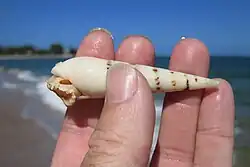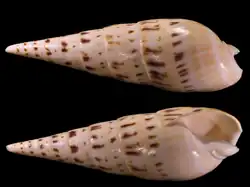Oxymeris maculata
| Oxymeris maculata | |
|---|---|

| |
| live Oxymeris maculata | |

| |
| shells of Oxymeris maculata | |
| Scientific classification | |
| Kingdom: | Animalia |
| Phylum: | Mollusca |
| Class: | Gastropoda |
| Subclass: | Caenogastropoda |
| Order: | Neogastropoda |
| Family: | Terebridae |
| Genus: | Oxymeris |
| Species: | O. maculata
|
| Binomial name | |
| Oxymeris maculata | |
| Synonyms[1] | |
| |
Oxymeris maculata, also called marlinspike auger, is a species of sea snail, a marine gastropod mollusc in the family Terebridae, the auger snails. It can be found in tropical climates at depths of 0 to 210 meters.[2]
Description
Oxymeris maculata has a cream colored shell with dark, rectangular spots that span the spiral.[3] It is the largest Terebrid species, with an average shell height of 16 centimeters[2] and reaching up to 27.4 centimeters.[4] This species feeds on smaller gastropods and echinoderms, including the Crown of Thorns sea star[5] and polychaete worms.[3] It is one of the many species within the Terebridae family to lose its venom ducts.[6]
Distribution and habitat
Oxymeris maculata can be found in the tropical Indo-Pacific, such as off Aldabra, Chagos, Madagascar, the Mascarene Basin, Mauritius and Tanzania. This species can also be found in the Pacific Ocean off Mexico, Papua New Guinea,[7] and Hawaii. In Hawaii it can be found off the beaches in places such as Waimānalo, Kahe Point, and Honokōhau.[8]
Human use
Oxymeris maculata is sometimes collected to eat the snail inside the shell.[2] It has also been used as a boring tool in South Pacific cultures.[2] Its common name, marlinspike, comes from its shape that is similar to the nautical tool used for splicing ropes.[9]
References
- ^ Oxymeris maculata (Linnaeus, 1758). Retrieved through: World Register of Marine Species on 30 March 2011.
- ^ a b c d "Oxymeris maculata, Marlinspike : fisheries". www.sealifebase.se. Retrieved 11 August 2025.
- ^ a b Hoover, John P. (1998). Hawai'i's sea creatures: a guide to Hawai'i's marine invertebrates. Honolulu, Hawaii: Mutual Pub. ISBN 978-1-56647-220-3.
- ^ Fedosov, Ae; Tiunov, Av; Kiyashko, Si; Kantor, Yi (5 February 2014). "Trophic diversification in the evolution of predatory marine gastropods of the family Terebridae as inferred from stable isotope data". Marine Ecology Progress Series. 497: 143–156. doi:10.3354/meps10585. ISSN 0171-8630.
- ^ "Marine Invertebrates". newheavenreefconservation.org. Retrieved 28 July 2025.
- ^ Olivera, Baldomero M.; Showers Corneli, Patrice; Watkins, Maren; Fedosov, Alexander (1 February 2014). "Biodiversity of Cone Snails and Other Venomous Marine Gastropods: Evolutionary Success Through Neuropharmacology". Annual Review of Animal Biosciences. 2 (1): 487–513. doi:10.1146/annurev-animal-022513-114124. ISSN 2165-8102.
- ^ "WoRMS - World Register of Marine Species - Oxymeris maculata (Linnaeus, 1758)". www.marinespecies.org. Retrieved 11 August 2025.
- ^ "Marlinspike Auger, Terebra (Oxymeris) maculata". www.marinelifephotography.com. Retrieved 11 August 2025.
- ^ "Oxymeris maculata, Marshall Islands". www.underwaterkwaj.com. Retrieved 11 August 2025.
- Bratcher T. & Cernohorsky W.O. (1987). Living terebras of the world. A monograph of the recent Terebridae of the world. American Malacologists, Melbourne, Florida & Burlington, Massachusetts. 240pp.
- Severns, M. (2011). Shells of the Hawaiian Islands - The Sea Shells. Conchbooks, Hackenheim. 564 pp
External links
- Linnaeus, C. (1758). Systema Naturae per regna tria naturae, secundum classes, ordines, genera, species, cum characteribus, differentiis, synonymis, locis. Editio decima, reformata [10th revised edition, vol. 1: 824 pp. Laurentius Salvius: Holmiae]
- Fedosov, A. E.; Malcolm, G.; Terryn, Y.; Gorson, J.; Modica, M. V.; Holford, M.; Puillandre, N. (2020). Phylogenetic classification of the family Terebridae (Neogastropoda: Conoidea). Journal of Molluscan Studies. 85(4): 359-388
![]() Media related to Oxymeris maculata at Wikimedia Commons
Media related to Oxymeris maculata at Wikimedia Commons